
A straight-four engine is a four-cylinder piston engine where cylinders are arranged in a line along a common crankshaft.

The straight-six engine is an internal combustion engine, with six cylinders mounted in a straight line along the crankcase with all the pistons driving a common crankshaft.

The Volvo 164 is a 4-door, 6-cylinder luxury sedan unveiled by Volvo at the Paris Motor Show early in October 1968 and first sold as a 1969 model. 46,008 164s were built before the car was succeeded by the 264 in 1975. The 164 was Volvo's first venture into the luxury segment since the end of PV 60 production in 1950, and was the first six-cylinder Volvo since the PV800 last produced in 1958.

The Volvo V50 is the station wagon version of the Volvo S40 small family car first unveiled at the 2003 Bologna Motor Show, both assembled at Ghent, Belgium. Sharing the Ford C1 platform with the European Ford Focus and the Mazda 3, the V50 featured interior "theatre" lighting, a floating center stack and "Volvo Intelligent Vehicle Architecture".

The Volvo S80 is an executive car produced by the Swedish manufacturer Volvo Cars from 1998 to 2016 across two generations. It took the place of the rear-wheel-drive S90 as Volvo's flagship sedan.

The Essex V4 is a V4 petrol engine manufactured by the Ford Motor Company from 1965 to 1977. The engine was available in both 1.7 L and 2.0 L capacities. Designed by Ford of Britain, the Essex V4 was produced at a plant in Dagenham, originally in the county of Essex, later part of East London. The engine was used in the Ford Corsair, Capri Mk I, Consul/Granada Mk I, Ford Zephyr Mk IV and the Ford Transit Mk I van.
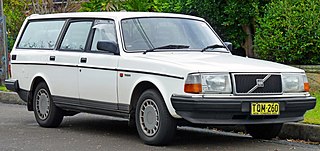
The Volvo 200 Series is a range of mid-size cars produced by Swedish company Volvo Cars from 1974 until 1993, with more than 2.8 million total units sold worldwide. Like the Volvo 140 Series, from which it was developed, it was designed by Jan Wilsgaard.
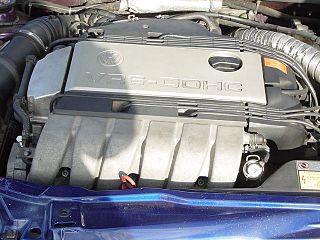
VR6 engines are V6 piston engines with a narrow angle between the cylinder banks and a single cylinder head covering both banks of cylinders.

The Jaguar XK is an inline 6-cylinder dual overhead camshaft (DOHC) engine produced by Jaguar Cars between 1949 and 1992. Introduced as a 3.4-litre, it earned fame on both the road and track, being produced in five displacements between 2.4 and 4.2-litres for Jaguar passenger cars, with other sizes being made by Jaguar and privateers for racing. A de-rated version was also used in certain military vehicles built by Alvis and Daimler.

The Triumph slant-four is an inline four-cylinder petrol car engine developed by the Triumph Motor Company. It first appeared in 1968 in the Saab 99. The first Triumph model to use the engine did not appear until 1972. With an original capacity of 1.7 L, displacement grew over time to 2.0 L. Production ended in 1981.
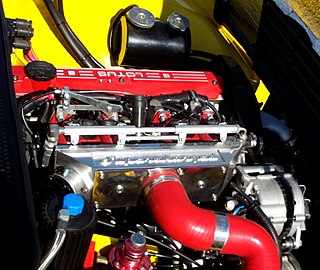
The Lotus 900 series is a family of internal combustion engines designed and built by Lotus Cars of United Kingdom. Successor to the Lotus-Ford Twin Cam, the 900 was the first complete engine developed by Lotus. The engine was built from 1972 to 1999.
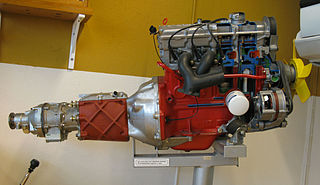
The Volvo B21 is a slant straight-four engine first used in the Volvo 200 series, meant to replace the B20. The B21 and all derived engines are often referred to as red block engines for the red paint applied to the block. The primary differences when compared to the B20 was the switch to a SOHC in place of the older pushrod configuration, and an aluminum crossflow cylinder head versus the iron head of the B20.

The Volvo 700 series is a range of executive cars produced by the Swedish manufacturer Volvo Cars from 1982 to 1992. The 700 series was introduced in 1982 with the luxurious 760, followed two years later by the lower priced 740 which capitalized on the prestige attained by the very similar 760. The 700 series was then gradually replaced, beginning in 1990, by the 900 series. The 700, designed by Jan Wilsgaard, was originally to have been a replacement for the 200 series, but production of that model continued until the early nineties. The expensive 780, a Bertone-designed coupé version, entered production in 1986 and departed without a direct successor only four years later.

The Volvo D5 is a type of turbocharged diesel engine developed by Volvo Cars for use in its passenger cars. The D5 engine is based on the Volvo Modular petrol engine. The D5 displaces 2.4 liters; a smaller series of two-litre engines were developed in 2010 and marketed as the Volvo D3 and D4.

The B8444S is an automobile V8 engine developed by Yamaha Motor Corporation for Volvo Cars. It was built in Japan and based on Volvo designs.
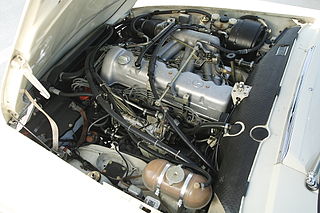
The Mercedes Benz M180 Engine was a 2.2 L; 134.0 cu in (2,196 cc) single overhead camshaft inline-6 cylinder engine introduced at the Frankfurt Motor Show in April 1951 to power the company's new 220 (W187). It was the first engine with a cylinder bore greater than its stroke that Mercedes had installed in a production car, while using a reverse-flow cylinder head.
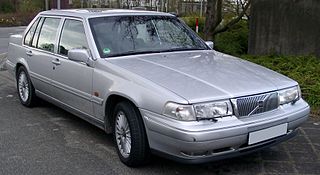
The Volvo 900 Series is a range of executive cars produced by the Swedish manufacturer Volvo Cars from 1990 to 1998. The 900 Series was introduced in 1990 to replace the 700 Series from which it derived. Prior to the end of its production, the 960 was renamed as the Volvo S90 (saloon) and Volvo V90 (estate), and the 940 was renamed 940 Classic, becoming the last rear-wheel-drive cars from Volvo.
The Volvo B36 is a petrol V8 automobile engine designed and built by Volvo. It first appeared in a concept car in 1952, and was later used in Volvo's truck line from 1956 to 1966.

















